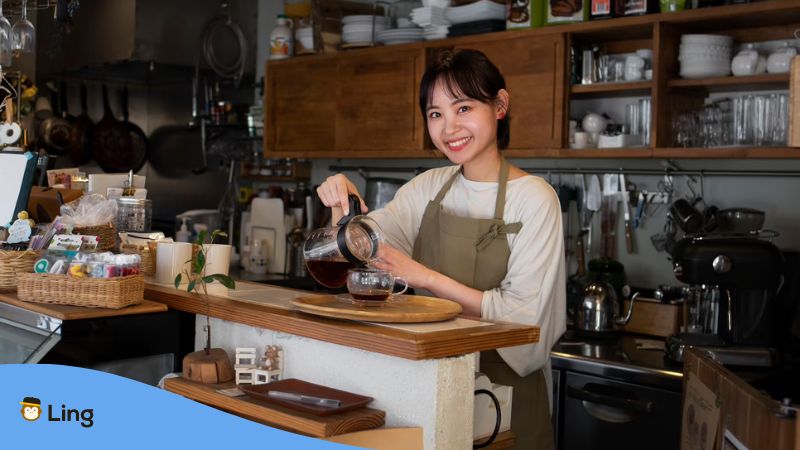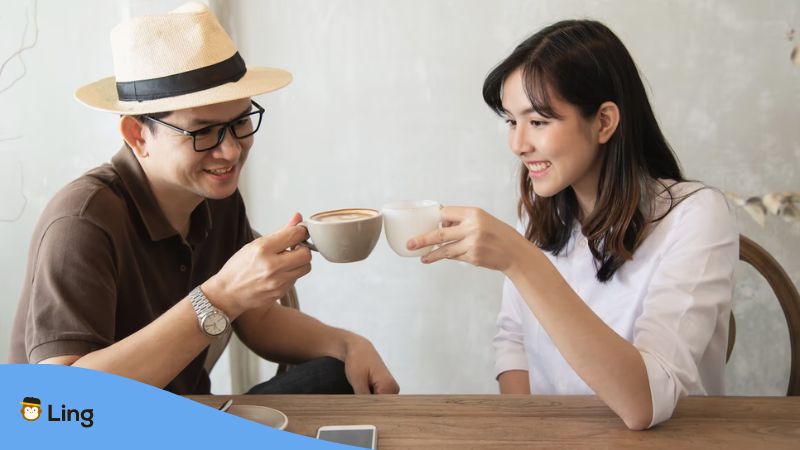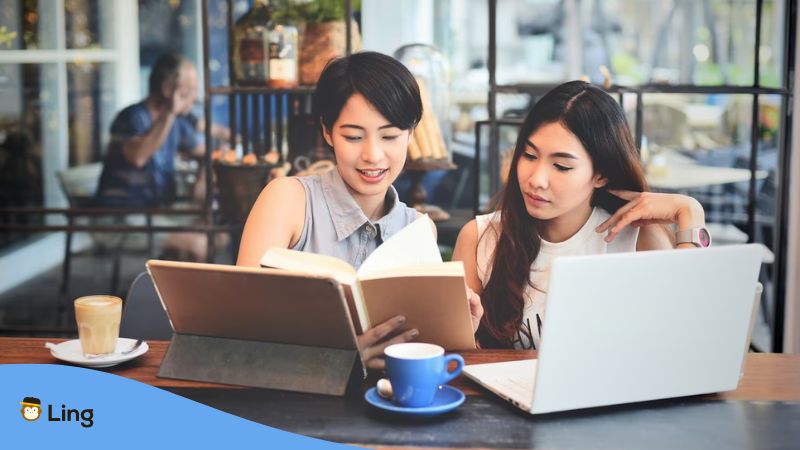Ever craved something beyond the everyday coffee experience?
Picture this: you’re in a South Korean café, a spot where each cup tells a tale. Intriguing, right?
Welcome to the fascinating cafe culture in South Korea or 커피 문화 (keopi munhwa)!
Why all the buzz, you ask?
Here’s the thing. It’s more than just 커피 (keopi – coffee) here. From the themes and the ambiance to the distinct Korean touch, it’s a rich blend.
Ready to dig deeper? Let’s discover the story of Korea’s captivating café scene step by step while learning the Korean language.
Let’s start this aromatic ride!
1. Korean Cafe Culture History
Before we dive in, let’s take a quick peek at the past. Let’s unravel the journey of coffee in Korea.
The Advent Of Coffee In Korea
Coffee first came to Korea in the late 18th century through diplomats and officials who tasted this unique drink during their overseas visits.
This new beverage quickly caught the interest of the elite, and the first cafes, known as 다방 (dabang or tearoom), sprouted in the cities.
This gradually introduced coffee to the broader population.
Influence Of The Korean War
Now, fast forward to the Korean War. This period of turmoil brought about an unexpected coffee twist.
Can you guess? Yes, instant coffee!
American soldiers had it in their ration packs, introducing Koreans to the convenience of instant coffee.
As the country rebuilt, instant coffee became a comforting symbol of modern life.
Transition From Instant Coffee To Artisanal Brews
As the country’s economy grew, so did its tastes. The late 1990s marked a shift.
Koreans started craving more: more quality, more flavors, and more experiences.
Enter artisanal coffee shops, where coffee isn’t just a drink but an art form.
Today, skilled baristas and unique cafes are familiar sights, each brewing its unique story.

2. The Korean Cafe Landscape
Let’s zoom in on the current coffee scene in South Korean cities. From bustling city corners to quaint countryside locales, coffee shops are everywhere. Let’s break it down.
Rise Of Coffee Shops
Cafes, or 카페 (ka-pe), exploded onto the Korean scene in the early 2000s.
Suddenly, there was a café on every street, then every corner.
Why, you ask?
Cafes became places to relax, work, socialize, and of course, enjoy a good cup of coffee.
Are there really that many coffee lovers?
Well, it turns out, yes!
Koreans drink coffee at an average of 360+ cups per person annually.
Dominance Of Franchises
If you’ve strolled down a Korean street, you’ve likely seen the big names.
Starbucks, Angel-in-us, Caffé Bene, you name it!
Franchises have a massive presence here. Why is that?
They offer consistency, familiarity, and, sometimes, status.
Believe it or not, a cup of Starbucks coffee is often seen as a status symbol.
But it’s not just about the big names…
Emergence Of Independent Cafes
Enter independent cafes, or 독립 카페 (doklip ka-pe). They’re the fresh faces in the coffee scene.
These unique coffee shops are all about personality.
Each cafe is a world of its own, with unique themes, custom brews, and one-of-a-kind experiences.
Want to sip coffee in a greenhouse or perhaps a retro vinyl store?
In Korea, there’s a coffee shop for that!
From book cafes to dog cafes, these independent places are reinventing the coffee experience!
3. Korean Cafe Culture: Diverse Themes And Unique Experiences
Korea’s cafe scene is famed for its creativity. Variety is the spice of life, and Korean cafes take this to heart.
Animal Cafes
Animal cafes in Korea take ‘paws’ for a coffee to the next level.
Try ‘Cat Attic’ (고양이 다락방) in Gangnam, where you can make furry friends with over 20 cats of various breeds while sipping your coffee.
Or ‘Bau House’ (바우하우스) in Mapo District, a haven for dog lovers, where you can play with dogs of different sizes and breeds.
Can you imagine a cuter coffee break?
Hanok (Traditional House) Cafes
한옥 (Hanok) cafes combine traditional Korean architecture with the modern cafe scene.
For instance, ‘Cha Masineun Tteul’ in Bukchon offers tea and coffee in a tranquil, restored hanok.
‘Gyedong Café’ in Jongno District serves delicious brews in a renovated hanok with a beautiful garden view.
It’s a calming retreat amidst the urban bustle!
Music And Art Cafes
Music and art cafés offer a feast for your senses.
Some examples are ‘Cafe B-hind’ in Hongdae, known for its jazz music and retro vibe, and ‘Club FF,’ which is a part indie music venue, part café.
And there’s ‘Gallery Café Gahoedong60’ where you can enjoy coffee while perusing their rotating art exhibitions.
Celebrity-Owned Cafes
Celebrity-owned cafés add a dash of stardom to your coffee experience.
‘AND.here’ in Jeju, owned by G-Dragon of BigBang, features stunning architecture and exclusive merchandise.
Or ‘Mouse Rabbit,’ owned by Super Junior’s Yesung, a cozy spot that fans love.
Ever thought you’d share a coffee spot with a member of an old-school K-pop group?

4. Specialty Coffee And Korean Coffee Consumption
Let’s talk about the serious side of coffee: the beans, the brews, and the habits that have shaped Korea’s cafe culture.
The Third Wave Coffee Movement
Korea’s no stranger to the Third Wave Coffee Movement.
This global trend emphasizes high-quality, artisanal coffee, treating coffee brewing as an art.
Cafés like ‘Fritz Coffee Company’ in Seoul are at the forefront, championing specialty brews and educating customers about the coffee-making process.
Coffee Bean Sourcing And Roasting
Korean cafes are taking control of their coffee from bean to cup.
Some, like ‘Törö Coffee Roasters,’ source and roast their beans, ensuring quality at every stage.
This meticulous attention to detail elevates the coffee experience of cafe culture in South Korea.
Koreans’ Coffee Drinking Habits
Koreans love their coffee. On average, a Korean adult drinks coffee twice a day.
With such a high consumption rate, it’s not surprising that both global franchises and local coffee houses thrive here.
Interestingly, this love extends beyond just the beverage to the atmosphere and experiences that Korean cafes provide.
5. Korean Cafe Culture In Pop Culture
The impact of cafe culture extends beyond our coffee cups. It infiltrated pop culture, especially Korean dramas and music.
Cafes In Korean Dramas And Movies
Korean dramas like ‘Coffee Prince’ and ‘Café Amoré’ have plots revolving around cafes, mirroring the importance of cafe culture in Korean life.
They’ve also boosted cafe tourism, with fans flocking to filming locations for a taste of the drama.
Impact Of K-Pop On Cafe Culture
K-pop has also embraced cafe culture, with album launches, fan meetings, and themed cafes like ‘SM Town Café’ linked to major K-pop labels.
It’s a unique synergy between coffee and K-pop, creating a fascinating cultural blend.
So, as you can see, Korea’s cafe culture is deeply woven into its societal and pop culture fabric.
It’s more than just a cup of coffee. It’s a lifestyle.
6. Environmental Consciousness In Korean Cafes
Korean cafes aren’t just brewing good coffee. They’re also brewing eco-friendly ideas. How? Let’s spill the (coffee) beans!
Efforts Towards Sustainable Practices
‘Coffee Libre’ in Yeonnam-dong is leading by example.
These fancy coffee shops serve fair-trade beans and talk about eco-friendly farming.
But there’s more!
Places like ‘Takeout Drawing’ in Hannam-dong are hosting eco-themed art shows.
They’re serving up good coffee and even better eco-ideas.
Reducing Single-Use Plastics
Korean cafes are waging war on plastic too!
‘Caffe Bene’ and ‘Ediya Coffee’ are on the front line.
They offer discounts for customers who bring their own mugs.
Yes, a small change, but every little bit counts in saving the planet, right?

7. Korean Cafes: More Than Just Coffee
But let’s not forget. Korean cafes are more than just places to grab a coffee.
They’re hubs of social and intellectual activity.
Cafes As Social Gathering Spaces
Cafes are the new “it” place for socializing. They’re places where friends meet, lovers date, and families bond.
They’ve become a staple of Korean social life.
A case in point? The bustling ‘Garosu-gil’ (가로수길) in Sinsa-dong.
It’s a vibrant hub where friends gather, couples go on dates, and families come together.
Work And Study Spaces
Are workplaces and libraries too noisy? Korean cafes to the rescue!
They offer quiet and cozy corners for work or study.
Take ‘Cafe Alver’ in Gangnam, for instance. It’s a favorite among professionals and students alike.
In a nutshell, Korean cafes have redefined their incomparable coffee culture.
They’re not just places to enjoy a cup of Joe. They’re spaces where life happens.
Korean Coffee Culture-Related Vocabulary
Language, as we believe, is the window to a culture.
To immerse ourselves deeper into the Korean cafe scene, we need to familiarize ourselves with the language of coffee in Korea.
So, let’s brew up some knowledge with these Korean words that will bring us closer to the heart of Korean cafe culture.
These words vividly depict the integral elements that shape Korean cafe culture.
So, next time you visit a cafe in Korea, why not try using these words?
You’ll be ordering your coffee like a local, gaining a richer understanding of Korea’s cafe culture.
Explore The Cafe Culture In South Korea With Ling!
As our discussion about cafe culture in South Korea comes to a close, let’s reflect on the flavors we’ve tasted and the stories we’ve uncovered.
It’s time to take the next step!
So, why not embark on a language adventure with Ling?
Discover the richness of Korean and over 60+ languages with the Ling app.
Whether you’re sipping a latte or enjoying a cup of tea, make every moment a chance to learn and connect.
Don’t miss out!
Grab the Ling app from Google Play and App Store and let the language exploration begin.
Cheers to a world of cultures waiting to be discovered!


































































